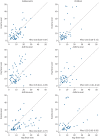The burden of asthma, hay fever and eczema in children in 25 countries: GAN Phase I study
- PMID: 35144987
- PMCID: PMC9474895
- DOI: 10.1183/13993003.02866-2021
The burden of asthma, hay fever and eczema in children in 25 countries: GAN Phase I study
Abstract
Aims: There have been no worldwide standardised surveys of prevalence and severity of asthma, rhinoconjunctivitis and eczema in school children for 15 years. The present study aims to provide this information.
Methods: Following the exact International Study of Asthma and Allergies in Childhood (ISAAC) methodology (cross-sectional questionnaire-based survey), Global Asthma Network (GAN) Phase I was carried out between 2015 and 2020 in many centres worldwide.
Results: The study included 157 784 adolescents (13-14 years of age) in 63 centres in 25 countries and 101 777 children (6-7 years of age) in 44 centres in 16 countries. The current prevalence of symptoms, respectively, was 11.0% and 9.1% for asthma, 13.3% and 7.7% for rhinoconjunctivitis and 6.4% and 5.9% for eczema. The prevalence of asthma ever was 10.5% and 7.6%, hay fever ever was 15.2% and 11.1% and eczema ever was 10.6% and 13.4%, respectively. Centres in low or lower middle gross national income countries (LICs or LMICs) had significantly lower prevalence of the three disease symptoms and diagnoses (except for hay fever). In children, the prevalence of asthma and rhinoconjunctivitis symptoms was higher in boys, while the reverse occurred among adolescents. For eczema, while the prevalence among female adolescents was double that of males, there was no sex difference among children. Centre accounted for non-negligible variability in all disease symptoms (10-20%).
Conclusion: The burdens of asthma, rhinoconjunctivitis and eczema vary widely among the limited number of countries studied. Although symptom prevalence is lower in LICs and LMICs, it represents a considerable burden everywhere studied.
Copyright ©The authors 2022.
Conflict of interest statement
Conflict of interest: C.E. Rutter declares UK Medical Research Council funding for a PhD as part of MRCLID DTP with LSHTM and St Georges, grant number MR/N013638/1, in connection with the present manuscript. All other authors declare no competing interests.
Figures



Comment in
-
Planetary respiratory health for asthma, rhinoconjunctivitis and eczema.Eur Respir J. 2022 Sep 15;60(3):2200440. doi: 10.1183/13993003.00440-2022. Print 2022 Sep. Eur Respir J. 2022. PMID: 36109045 No abstract available.
References
-
- Asher MI, Ellwood P, Gilchrist C, et al. . The Global Asthma Report 2018. Auckland, New Zealand, The Global Asthma Network, 2018.
-
- Global Burden of Disease 2019. https://vizhub.healthdata.org/gbd-compare/ Date last accessed: November 13, 2021.
